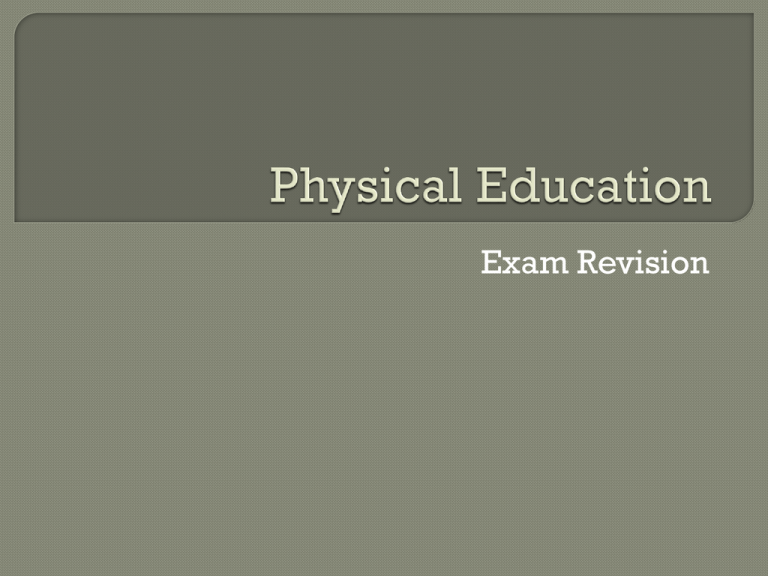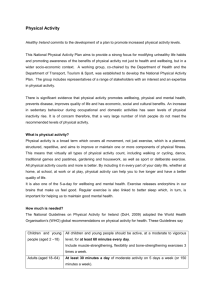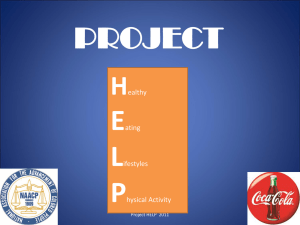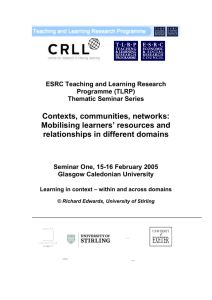Physical Education Sem 2 Exam Revision - Lalor-1-2PE
advertisement

Exam Revision Effective Coaching Practices • Skill learning principles and practice • The coaching toolbox – characteristics, skills and responsibilities Physically Active Lifestyles • PA concepts and health outcomes • National Physical Activity Guidelines • Factors influencing PA Promoting Active Living • Promoting active living Skill Classification Skill Development Learning Styles Stages of Learning THREE categories of classification • Movement precision GROSS or FINE • Type of Movement DISCRETE, CONTINOUS or SERIAL • Predictability of the environment OPEN or CLOSED Gross motor skills involve movements that use large muscle groups and make big movements, eg kicking a football Fine motor skills involve smaller movements with smaller muscle groups, eg writing or bouncing a tennis ball Discrete skills are those that have a distinct start and finish, eg A tennis serve Continuous skills are those that share a repetitive motion, eg swimming or running Serial skills are those that involve linking discrete skills together, eg gymnastics or dance routines Open skills are those that the individual needs to adapt to, with external factors influencing what needs to be done, eg golf shot outside on a windy day Closed skills are largely easier with no external influences. They are completely controlled by the individual, eg ten pin bowling Cognitive Associative Autonomous Cognitive stage: the “beginner” level of skill development. Involves many mistakes but shows fast improvement Associative stage: more consistent and less mistakes. Can tell why some errors occur and develop strategies to overcome them Autonomous stage: can detect their own errors and correct them, movement happens automatically Visual learners Auditory learners Kinaesthetic learners Visual learners: learn by seeing things. These may be plays on the board, where to stand etc Auditory learners: learn by listening to what needs to be done. “You need to stay in the hot spot” Kinaesthetic learners: learn by doing. Going through plays rather than just talking about them Blocked • Same skill continuously, eg serve only Random • Different skills in the same training session, eg serve, forehand, backhand, volley etc. Part, whole, massed and distributed pg 213-5 Internal • Performers use their own senses to see, feel etc what happened External • When others give insight to an athletes performance Authoritarian: Strict and demands discipline. Punishes for poor performance Casual: More of a supervisor than a coach. Lets players run the training sessions Democratic: Delegates roles to assistants Co-operative: Works with the players to receive input Managing risk Abiding by the Coach’s Code of Behaviour Keeping good player – coach relationships Staying out of trouble and within ethical boundaries Professional development Gaining accreditation and coaching pathways Coaching juniors, working with parents Working with officials Planning and reviewing Communication skills Motivation skills Leadership Conflict resolution Understanding of group dynamics Essential knowledge Of the sport Skill acquisition and biomechanics Sports psychology Injury prevention Sports nutrition Tactical and strategic sense Domains of Physical Activity Dimensions Health of Physical Activity Benefits of Physical Activity Consequences of Inactivity The main domains of PA are • Leisure time • Household/gardening • Occupational • Active Transport The following can also be seen as domains • Play • Exercise • Organised sport Dimensions of PA are different to domains of PA They are these: • Frequency – How often PA is done • Intensity – How hard (HR) the activity is • Type – Weights, Cardio, Interval, Circuit, Flexibility etc • Duration – How long the individual exercises for Improved cardiovascular function Improved strength and muscular endurance Resistance to fatigue Enhanced mental health and function Opportunity for successful experience and social interaction Improved appearance Greater lean body mass and less body fat Improved flexibility Bone development Reduced cancer risk Reduced effect of aging Improved wellness Type 2 diabetes Obesity Cardiovascular disease Hypertension High cholesterol levels Guidelines put in place by the government to minimise costs brought about by preventable illnesses caused by inactivity All different for children, youth, and adults Birth – 1 year: • Floor based play 1-3: • Active for at least 3 hrs a day, every day • Younger than 2, no TV or electronic media • Maximum inactivity time = 1 hr At least 60mins activity (up to several hrs) moderate – vigorous activity every day No more than 2 hours using electronic media for entertainment At least 60mins activity moderate – vigorous activity every day No more than 2 hours using electronic media for entertainment Think of movement as an opportunity, not an inconvenience Be active every day in as many ways as you can At least 30mins of moderate intensity PA on most, if not all days Some regular vigorous PA for extra health and fitness Some form of activity no matter what Be active in as many ways as possible 30mins of moderate activity every day Start at least at a level that is appropriate Continue a lifetime of PA that you enjoy More PA (age appropriate) than is currently being undertook At least 60mins activity every day Once weight has been lost, 60-90mins activity a day to avoid weight regain Socioeconomic status • Income, education, where you live Cultural background • What you think is important, culturally Environmental factors • Trees, water, family Social factors • Peers, spouse, family Physical environment • Buildings, walking tracks, recreational facilities Lack of time Social influence Lack of energy Lack of will power Fear of injury Lack of skill Lack of resources Assessment of Physical Activity Physical environment, social environment, and policy approaches to PA at home, workplace, school and in community settings Elements of effective programs Media communication tools used to promote PA Measured at two levels • Population level • Individual level Subjectively • More error ridden – recall surveys Objectively • More accurate – proxy diary logs Global Physical Activity Questionnaire International Physical Activity Questionnaire Active Australia Survey Multi-Activity Recall for Children and Adolescents Children Leisure Activities Survey Home Work School Community Physical environment approaches: changing the physical environment to make people more active Social environment approaches: making people more accessible to be active with Policy approaches: creating policies in which mandate, or at least encourage, more physical activity A program that encourages change in an individuals behaviour For a program to be successful, it must have 4 elements: • Formative evaluation – On going assessment • Process evaluation – collect data of implementation • Impact evaluation – achievement of program goals • Outcome evaluation – assessment of long term goals People see/hear/feel media everyday, hence why it is so powerful. Types of media that is effective include: TV Radio Billboards Magazines Web based information











